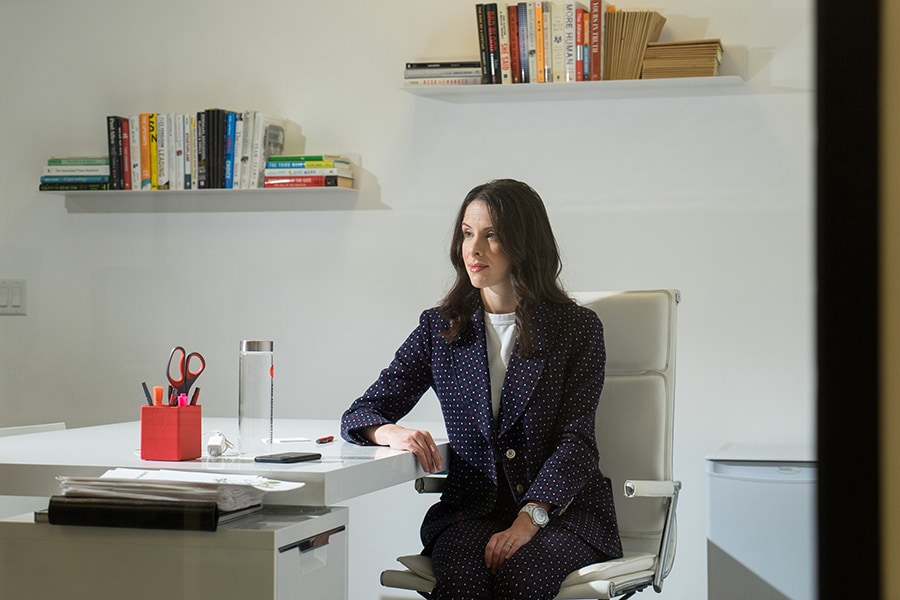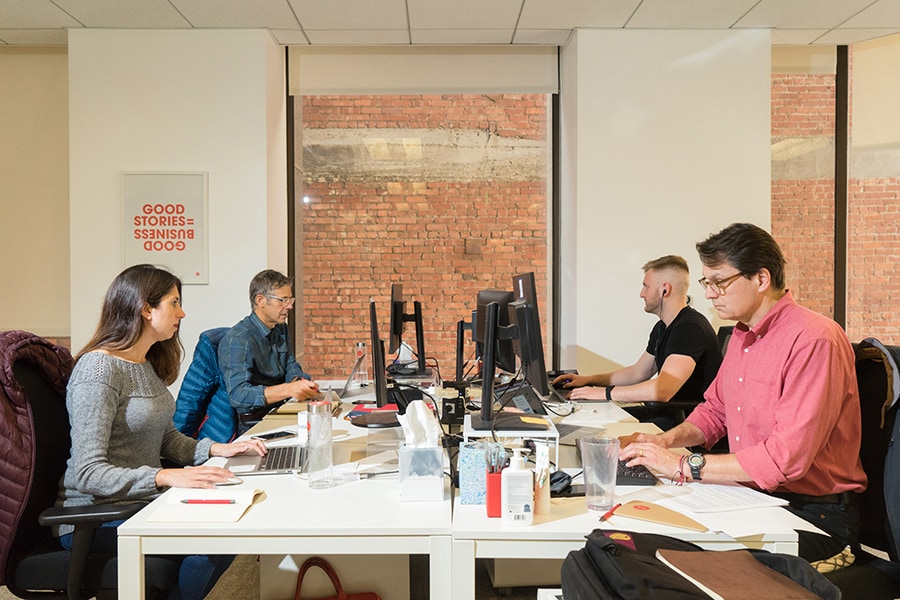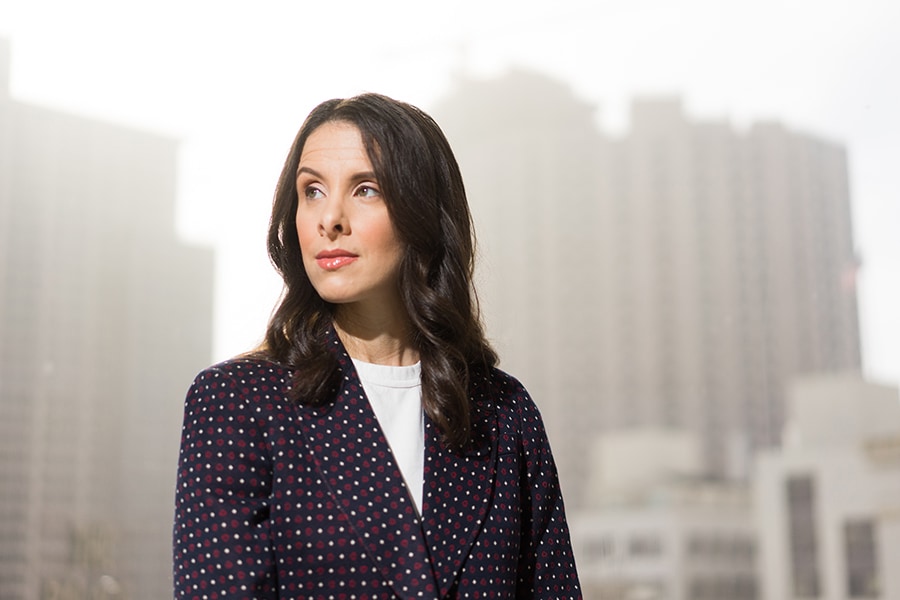
Maybe Information Actually Doesn't Want to Be Free
From analysis of Trump's utterances to conspiracy-peddling publishers amplifying themselves on Facebook and YouTube, tech stories increase exponentially every day
 Jessica Lessin, founder of The Information, an influential Silicon Valley publication, at their offices in San Francisco, Calif. on Nov. 8, 2019. Lessin, thinks most reporters are focusing on the wrong topics instead her site looks at the larger picture, pursuing industry scoops and keeping the publication ad-free, instead charging $399 a year for complete access. (James Tensuan/The New York Times)
Jessica Lessin, founder of The Information, an influential Silicon Valley publication, at their offices in San Francisco, Calif. on Nov. 8, 2019. Lessin, thinks most reporters are focusing on the wrong topics instead her site looks at the larger picture, pursuing industry scoops and keeping the publication ad-free, instead charging $399 a year for complete access. (James Tensuan/The New York Times)SAN FRANCISCO — Jessica Lessin thinks the biggest story of the moment — how tech is swallowing the universe — is hopelessly under-covered by the news media. The issue is “massive,” she said not long ago in her spare, cube-like office here, and “no one is paying attention.”
Of course, it can be hard to see the forest for the tweets. From analysis of Trump’s utterances to conspiracy-peddling publishers amplifying themselves on Facebook and YouTube, tech stories increase exponentially every day. But Lessin, founder of The Information, an influential Silicon Valley publication, thinks most reporters are still focusing on the wrong topics: glamorous cryptocurrency, for example, rather than the blockchain looming over bank loans and stock trades; or the number of cars sold, rather than the artificial intelligence and driver networks that threaten to make that number obsolete.
She has focused her site on the larger picture, pursuing industry scoops and keeping the publication ad-free, instead charging $399 a year for complete access. The Information achieved profitability in 2016, Lessin said, three years after she left The Wall Street Journal to start it. She added that she expected $20 million in sales by the end of 2020, and for her staff of two dozen reporters and editors in the Bay Area, Seattle, Los Angeles, New York, Washington and Hong Kong to grow. “The fact that we have a business that’s scaling makes me excited,” she said.
This sense of hope is discordant with the rest of online media, which seems in grim shape — last year, more than 1,000 people were laid off at BuzzFeed, AOL, Yahoo, HuffPost and Vice Media. (BuzzFeed is now back on more solid footing and could be headed for a sale.)
As other online organs have bloated and intermittently fasted, The Information’s reporters have become known in Silicon Valley for sniffing out the industry’s misdeeds and tweaking its powerful. A 2017 story revealed sexual harassment allegations against a venture capitalist that led to the shutdown of his firm. A recent article revealing hidden financial data at Quibi, a new streaming service, prompted its chief executive, Meg Whitman, to compare reporters to sexual predators. (She later apologized.)
The Information is sparely, almost clinically designed and frequently refreshed. Subscribers include Amazon’s founder, Jeff Bezos, and media investor James Murdoch (“Please write nice things about her,” he said of Lessin); corporate clients like Google and Goldman Sachs; and most of startup royalty. Laurene Powell Jobs, the world’s seventh wealthiest woman and an influential philanthropist who also owns The Atlantic, finds the site useful. It covers “an ecosystem and an industry I care about,” she said, adding, “I’ve followed Jessica’s byline since The Journal.”
Lessin, 36, is the rare editor to have risen from ink-stained wretch to a player, much like Peter Bart when he ruled Variety, or Anna Wintour of Vogue. But her success, unlike the editors of an earlier time, owes as much to the data-driven discipline of her business as her editorial tastes. In an era when many pay walls, if they exist at all, are easily scaled, Lessin is fiercely guarding the fortress.
“I’ve said this from the beginning,” she said, “and I continue to say this, but you can’t give away what you expect the reader to find valuable.”
‘Who the hell is this girl?’
Lessin’s instinct for tradecraft showed up before the internet was ubiquitous, when she was editor of The Greenwich Academy Press, the half-size broadsheet of her private high school, and wanted to publish it in full color. To raise the money, she persuaded the school to allow her to auction off parking spots. “I just really wanted it to look as big and professional as possible,” she recalled.
While attending Harvard, she scored the coveted faculty beat at the Crimson newspaper. “It was like covering Congress,” Lessin said. “It’s fun because you get the bickering and the politics.” Lauren Schuker Blum, a friend who worked with her there and later at The Journal, remembered Lessin’s work habits. “We all had these reporter notebooks and most of us would use like half of it, or lose it, but she had like 30 of them, impeccably detailed,” Schuker Blum said. “She was like a libel lawyer’s dream.”
 Employees of The Information, an influential Silicon Valley publication, work at their offices in San Francisco, Calif. on Nov. 8, 2019. Jessica Lessin, the sites founder, thinks most reporters are focusing on the wrong topics instead her site looks at the larger picture, pursuing industry scoops and keeping the publication ad-free, instead charging $399 a year for complete access.(James Tensuan/The New York Times)
Employees of The Information, an influential Silicon Valley publication, work at their offices in San Francisco, Calif. on Nov. 8, 2019. Jessica Lessin, the sites founder, thinks most reporters are focusing on the wrong topics instead her site looks at the larger picture, pursuing industry scoops and keeping the publication ad-free, instead charging $399 a year for complete access.(James Tensuan/The New York Times)After graduating in 2005, Lessin completed an internship at The Journal, then kept coming back into the office to pitch stories. Eventually, she landed a full-time job covering personal tech, one of the least popular beats at the time. The year was 2005. BlackBerrys were the gold standard of smartphones and Facebook was just an online phone book for college students.
In 2008, Lessin moved to San Francisco to cover the tech industry — and regularly broke stories. “I was like, ‘Who the hell is this girl?’” said Paul Steiger, the Journal’s managing editor at the time. “I kind of followed her work and asked people, ‘Is she as good as this looks?’ And they said yes.”
But it was also around this time that some people began to whisper about Lessin’s possible conflicts of interest. Through Harvard, she had become friends with startup founders or fast-rising executives at places like Google and Facebook, ostensibly her key subjects. She was also dating another graduate, Sam Lessin, who had started a company that would later be acquired by Facebook. (The two married in 2012.)
A holiday excursion in 2008 resulted in a scolding for Jessica Lessin. As the economy was plummeting, she and Sam Lessin jetted off to the vacation home of his family on the island of Cyprus with friends of theirs from the startup scene.
The group passed the time as many people do on vacation, drinking and lounging around the pool. And before filming such activities and sharing them with strangers would become commonplace on Instagram, they posted footage online, including the women wearing matching black-and-white checkered swimsuits, lip-syncing to Journey’s “Don’t Stop Believing.”
The Cyprus travelers were blasted for their stunning lack of self awareness as the nation’s economy teetered toward crisis and tech companies were laying off employees. Jessica Lessin was singled out by Valleywag, the now-defunct tech site, in a post headlined, “WSJ reporter parties in Cyprus with people she covers.”
“Oh, that never made sense to me,” she said. “These were not people I wrote about. These were friends.” (A scan of Journal articles from the period shows she interviewed at least one Cyprus attendee in an article — Mike Hudack, the head of Blip.tv, a video startup that has since shut down. Lessin says they were not friends when she wrote the article.) Still, her vacation drew disapproving scrutiny from higher-ups at The Journal, though not an official reprimand.
Lessin, in turn, was beginning to chafe at how newsrooms were covering tech — from a cool remove, she thought, never going deep. In contrast were the many bloggers who could delve into the industry’s every incremental move, but who had become so close to subjects the stories read like ad copy. Lessin said she thought: Couldn’t you do both? In-the-know reporting that still held subjects to account?
“I knew if I didn’t do it, someone else would, and I’d be kicking myself,” she said.
 Jessica Lessin, founder of The Information, an influential Silicon Valley publication, at their offices in San Francisco, Calif. on Nov. 8, 2019. Lessin, thinks most reporters are focusing on the wrong topics instead her site looks at the larger picture, pursuing industry scoops and keeping the publication ad-free, instead charging $399 a year for complete access. (James Tensuan/The New York Times)
Jessica Lessin, founder of The Information, an influential Silicon Valley publication, at their offices in San Francisco, Calif. on Nov. 8, 2019. Lessin, thinks most reporters are focusing on the wrong topics instead her site looks at the larger picture, pursuing industry scoops and keeping the publication ad-free, instead charging $399 a year for complete access. (James Tensuan/The New York Times)Starting with ‘less than $1 million’
Valley underminers like to snipe that Lessin never had to persuade investors to back her plan. She had her own money. Her father is Jerome C. Vascellaro, a partner at the private equity giant TPG, which is a significant investor in tech and media businesses like Uber, Vice and Airbnb. Her husband, a son of the late tech investor Robert H. Lessin, made a fortune from the Facebook stock he received as part of the company’s acquisition of his startup years ago.
Lessin said she tapped her own bank account, using “less than $1 million,” to start The Information, and continues to own and control it wholly. She pays competitive salaries (albeit without equity) — as much as $180,000 or more for some top reporters. She refuses to spend more than she grosses, she said.
So far, this strategy seems to be paying off. A 2016 article on Tony Fadell, then the head of Google’s Nest division, exposed how the executive’s last-minute decrees and slow decision-making had crippled the company’s hardware efforts. The story was so in demand it converted over 600 new subscribers in the first day, recalled the reporter who wrote it, Reed Albergotti, who worked at The Information from 2015 to 2019. “It blew up,” he said. “That was proof of the model.”
But is The Information — whose title anticipates an interest in nothing short of everything — just a trade publication, like Advertising Age or Publishers Weekly? (One heavily trafficked section features richly detailed organizational charts that executive recruiters mine for leads.)
Lessin, seeming a little annoyed by the question, tilting her head and widening her eyes as she computed her reply. “I think that misses the point,” she finally said. “There’s so much hunger for what we produce.”
In December, she introduced a consumer-friendly version of the site, an app called The Tech Top 10, priced at $30 a year. Instead of a dense story on Netflix’s debt structure, the app might publish a short explainer on Netflix’s price increase. “You’re matching the reader with the level of expertise they want,” Lessin said. “That’s what subscriptions allow you to do.”
She won’t say how many subscribers The Information has, but some back-of-the-envelope math suggests she’ll have to hit 40,000 paying readers by this year to reach her sales objective, which could be a significant challenge. According to three people familiar with the business, the publication surpassed 20,000 subscribers only around the middle of last year. “I can confirm we have more than that,” she said, declining to be more specific.
Her publication’s success has attracted suitors. Some time last year, John Ridding, the chief executive of The Financial Times, Britain’s pre-eminent business publication, met with Lessin in San Francisco. The salmon-colored broadsheet was interested in a possible takeover, three people familiar with the matter said. Ridding declined to comment, and Lessin said The Information was not for sale.
Nervous next to Bezos
As at any startup, the vibe at The Information’s open-plan offices is like a college dorm room that’s in the middle of being cleaned up ahead of Parents’ Weekend. A large part of the staff hails from The Journal, including Martin Peers, who used to be Lessin’s editor. Now, she’s his boss.
Peers, 59, is famous within journalism circles for his cantankerous nature and deep skepticism of Silicon Valley — and yet he came West. “I had been at the Journal for 15 years,” he said. “I was exhausted and what Jessica was proposing was the perfect antidote, and I thought, ‘Why not?’”
In June 2017, the site landed one of its biggest scoops: a feature that revealed sexual harassment allegations against one of Silicon Valley’s most well-connected venture capitalists. Six women had accused Justin Caldbeck, a partner at Binary Capital, of unwanted sexual advances, with three of them speaking to the reporter, Albergotti, on the record.
The story exposed a pervasive culture of misogyny and harassment within tech, immediately raised The Information’s profile and was a precursor of the broader #MeToo movement. But Albergotti, who now works at The Washington Post, remembered the staff’s anxiety as they got closer to publishing. They were keenly aware of what had happened to Gawker, which was sued for invasion of privacy by Hulk Hogan. The suit, which was financed by venture capitalist Peter Thiel, drove Gawker into extinction and stoked a fear among publishers that anyone with enough money and willpower could vaporize a news outlet.
As the Caldbeck story was about to go to press, Lessin was in Italy attending a conference. She consulted the company’s liability insurance, which she had printed out, in her hotel room before heading to a dinner where she would be seated with Jeff Bezos. “I don’t remember if I vomited or not,” she said. “But I was very nervous.” She gave the green light.
Caldbeck didn’t sue. Instead, he resigned. A short while later, his venture firm collapsed. As a female entrepreneur, Lessin felt The Information’s work was “deeply personal,” especially as several men in the industry, who had heard the piece was in the works, contacted her to suggest the claims were overblown. These were “men I respect, who I was close to,” she said.
She wouldn’t name them. Schuker Blum, who worked with her at The Journal, said Lessin is not a gossip, like many reporters. “She’s not the journalist who’s always complaining,” Schuker Blum said. “She’s not a conspiracy theorist. She sees the best in people.”
Daniel Ek, the chief executive of Spotify, said he found the occasional, critical story on his company “not unfair.” But he added that Lessin “has to walk a tightrope given the level of access that she has. That’s got to be tough.”
Lessin’s connections continue to raise eyebrows, particularly those to Facebook. She and her husband are friends with their Harvard classmates Mark Zuckerberg, the company’s chief executive, and his wife, Priscilla Chan, who runs the couple’s philanthropy efforts. They attended each other’s weddings and both have young children. (Lessin’s two boys, Lion and Maverick, are both under age 3.) Zuckerberg was at The Information’s launch party, where she joked that for the super-high subscription rate of $10,000 a story could be killed (but just one). Recently, Chan was a speaker at an Information event.
The Information has published tough stories on Facebook, including a 2016 piece that revealed a weakness in its business. A more recent article exposed tensions between Chinese employees and Facebook’s leaders. But so far, it has only taken smaller swipes at the tech giant.
So how does The Information write about a company run by a friend of the site’s owner, one that is also perceived as having failed democracy, if not the universe?
Lessin was circumspect, her contralto voice echoing slightly off the glass walls of her office. “I’m very careful to draw lines around my personal life,” she said. “We have very clearly defined our culture around getting the best, most accurate story possible.”
©2019 New York Times News Service














